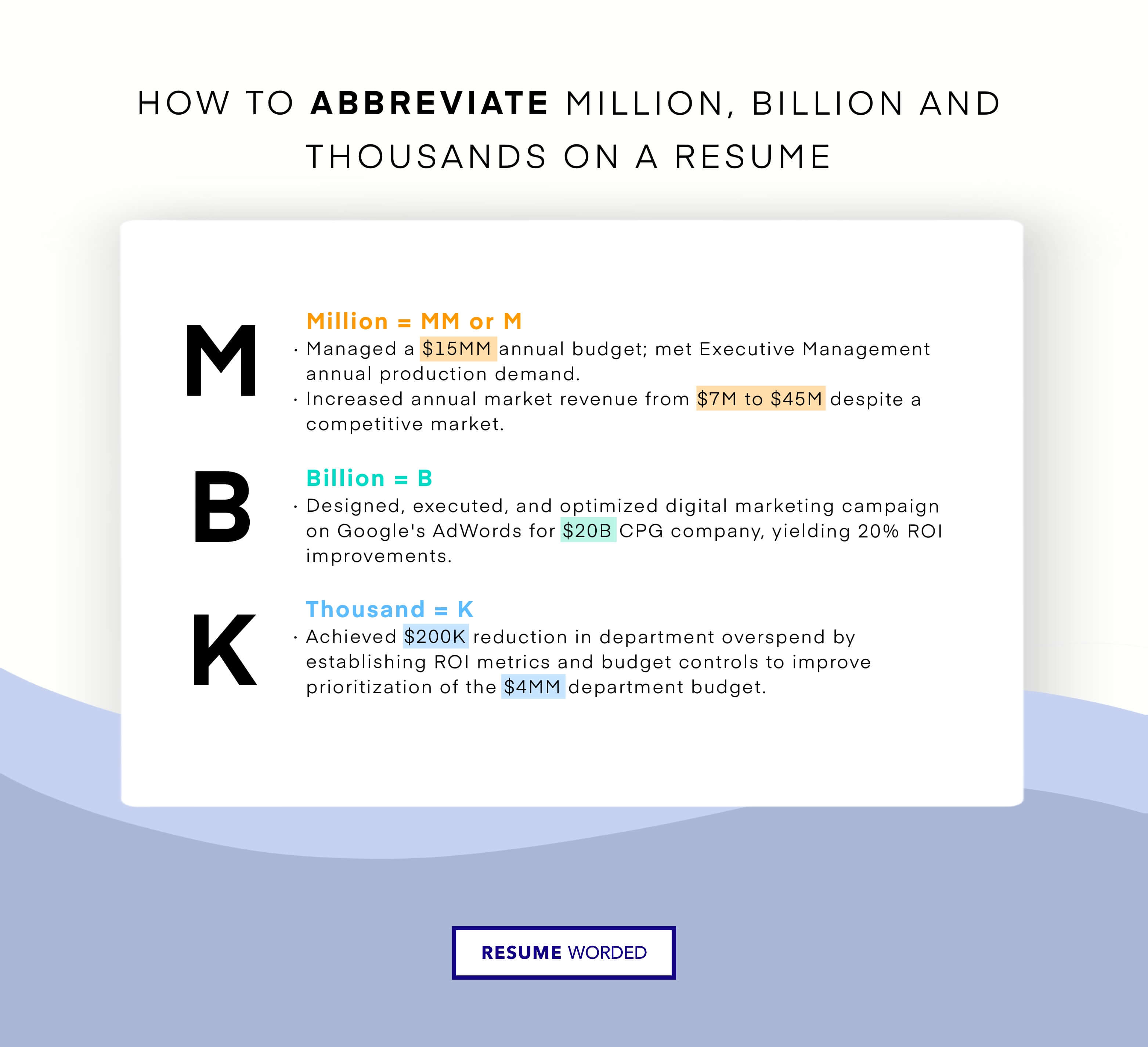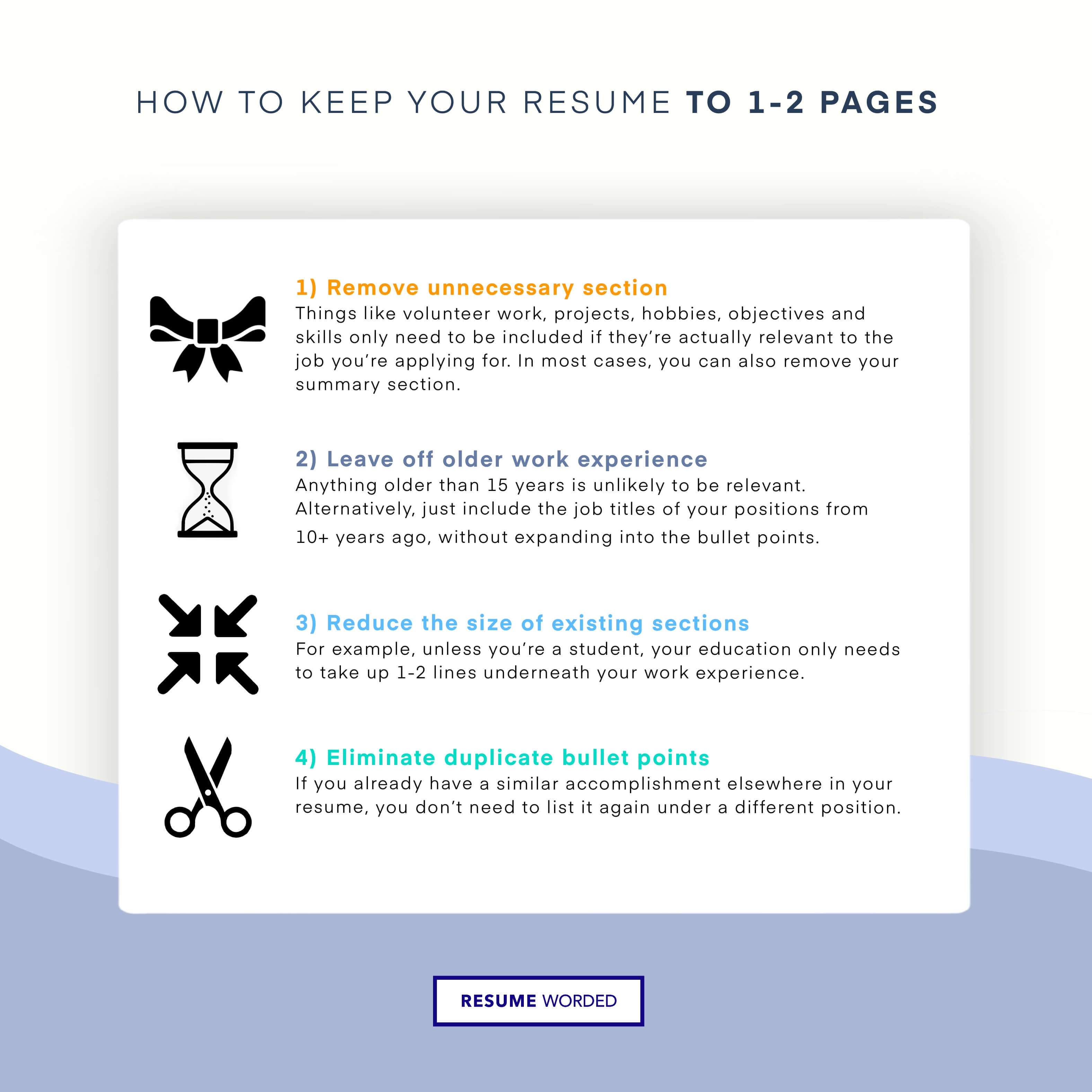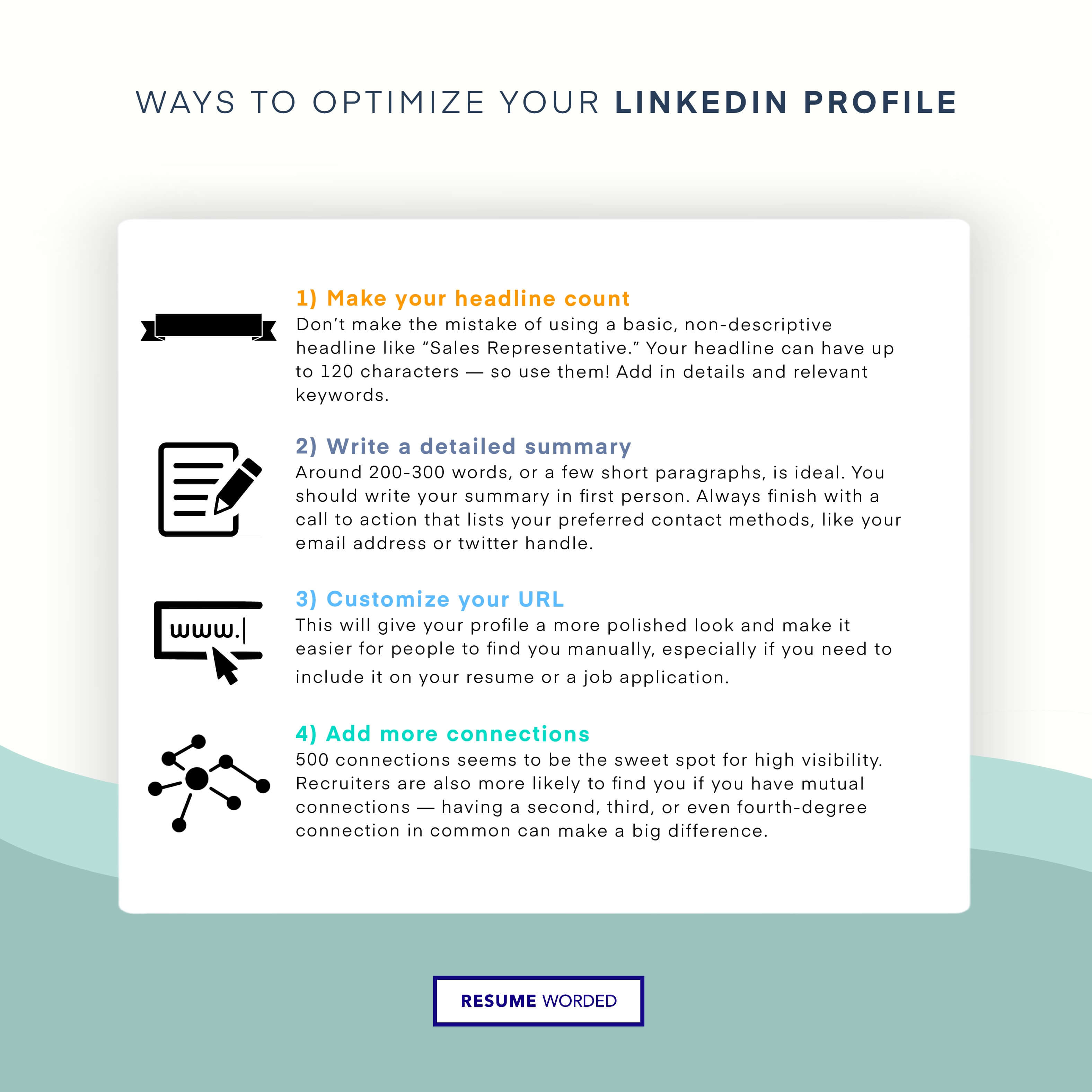Maximizing the impact of your resume is all about using your space wisely. Don’t use two words when one will do — and don’t spell out whole words when common abbreviations are easy to read and save space. In this guide, we’ll cover everything you need to know about how to abbreviate million, billion and thousand on a resume, as well as other common resume abbreviations you should be using.
How to abbreviate numbers on a resume
Here’s a quick reference to abbreviating numbers on your resume:
- Million = MM or M
- Billion = B
- Thousand = K
Scroll down for more tips on using abbreviations and examples of how to abbreviate numbers on your resume.
How to abbreviate million on a resume
The best (and most common) way to abbreviate millions on a resume is “MM.” It’s clear and easy to understand, which is the key to successfully abbreviating numbers.
You can also use “M.” This has historically been used to mean thousand, but is rarely used that way anymore, so it’s unlikely to cause confusion. If you say “10M” on a resume, recruiters will know that you mean million, not thousand.
So, “10,000,000” could become “10MM” or “10M.” “10 million” is also acceptable, but don’t use “10mill,” which is overly informal — stick to the more common abbreviations.
Examples:
Let's look at a few examples from real resumes of how to abbreviate million on a resume.
- Managed a $15MM annual budget; met Executive Management annual production demand.
- Increased annual market revenue from $7M to $45M despite a competitive market.
- Provided designing and programming support in enhancement of web applications accessed by over 3 million users worldwide.
How to abbreviate billion on resume
Similarly, the best way to abbreviate billions on a resume is “B.” You can spell out “billion,” but don’t use “BB” — the double letter is only used in millions to avoid confusion.
Examples:
- Designed, executed, and optimized digital marketing campaign on Google's AdWords for $20B CPG company, yielding 20% ROI improvements.
- Collaborated with portfolio managers toward managing $3 billion assets under management.
How to abbreviate thousand on a resume
Always use “K” to abbreviate thousands — never “M,” which is archaic and likely to cause confusion. Unlike “million” and “billion,” avoid spelling out “thousand” — instead, use the whole figure.
Example:
- Achieved $200K reduction in department overspend by establishing ROI metrics and budget controls to improve prioritization of the $4MM department budget.
- Developed standardized Separate Account portfolio reports, saving $50,000 annually in reports purchased.

Before sending out your resume, upload it to the tool below to ensure your sections, abbreviations, and bullet points are correctly identified. It’ll also identify any mistakes and give you suggestions for improvements.
When to spell out numbers on a resume (and when not to)
Should you spell out numbers in a resume, or use figures instead? It depends — different style guides will tell you different things, which means that this one is mostly a matter of preference. It is acceptable to:
- Spell out numbers up to 10 and use figures for numbers above 10
- Spell out numbers up to 100 and use figures for numbers above 100
- Use figures for all numbers
The key? Choose one and be consistent throughout.
Example:
- Supervised a team of four electricians responsible for cable pulling, tray installation, wiring of lights, and small power and lighting.
- Prepared over 15 detailed electrical design drawings in coordination with three other trades.
- Led the application development team to successfully launch the application on time with 6+ constraints, while ensuring adherence to the highest level of quality standards and meeting customer requirements.
When and how to give a range on a resume
If you want to give a range on your resume — for example, to indicate “more than” — you can use + or >. More than 10 million should become “10M+” or “>10M.” Don’t use “10+M,” which is clunky and confusing.
Example:
- Maintained 97% of cash on a portfolio of $2M+ on a monthly basis.
- Yielded >$900M a year in new revenue through vertical-based acquisition and demand generated product sales activity.
- Provided structural evaluations for 500+ projects with budgets ranging from $5 to $15 million.
How to abbreviate other figures on a resume
You might also want to use abbreviations to indicate physical size. To abbreviate “square foot,” use “ft2” — there’s no need to get fancy with superscript like “ft2”.
Example:
- Developed a 91-lease database in Access for a 600k ft2 Class A office building.
Why abbreviate million, billion and thousand instead of spelling it out?
- It saves space on your resume
- It’s less repetitive
- It’s easier to read — “2MM” is much easier to skim and quickly understand than “2,000,000.”
Other tips for using abbreviations on a resume
Be consistent
The most important thing to remember when using abbreviations on your resume is consistency. If you use “MM” in one place on your resume, use “MM” everywhere else — don’t switch between “MM,” “M,” “mm,” and “m.” Using different abbreviations interchangeably is confusing and can distract hiring managers from the substance of your resume.
Uppercase vs lowercase
Using uppercase (“MM”) or lowercase (“mm”) are both fine, as long as you’re consistent. Uppercase abbreviations are standard in the United States, while lowercase abbreviations are more common in some countries overseas, so keep that in mind when choosing which to use.
When not to use abbreviations
Stick to common abbreviations
Only use abbreviations on your resume when they are common and easily understood. Abbreviating “million” as “M” is fine, because recruiters can easily understand what you’re trying to say. Abbreviating “hundred” as “H” would be strange, because it’s not an abbreviation you’re likely to find anywhere else. Using uncommon abbreviations means a recruiter may spend more time trying to puzzle out what you’re trying to say than actually reading your resume (and may just decide to toss it aside and save themselves the headache).
Don’t use:
- Managed team of 2H employees, including 30+ direct reports.
Use this instead:
- Managed team of 200 employees, including 30+ direct reports.
Don’t use low-impact abbreviations
You don’t always need to use abbreviations on your resume! In particular, don’t abbreviate numbers when it lessens the impact of what you’re trying to say. This means you should avoid abbreviating numbers in the low thousands — for example, it’s better to use “1600” than “1.6K.”
Don’t use:
Designed strategy for large-scale operational transformation initiative encompassing 1.7K+ full-time employees (FTEs), resulting in 500 FTE savings.
Use this instead:
Designed strategy for large-scale operational transformation initiative encompassing 1700+ full-time employees (FTEs), resulting in 500 FTE savings.










